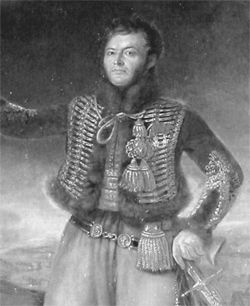General Jacques Gervais Subervie

Born: September 1, 1776
Place of Birth: Lectoure, Gers, France
Died: March 10, 1856
Place of Death: Ligueux, France
Arc de Triomphe: SUBERVIE on the south pillar
Pronunciation:
The son of a merchant, Jacques Gervais Suberive started his military career by joining the 2nd Battalion of Volunteers of Gers in June 1792 alongside his friends Jean Lannes and Pierre Banel. Elected a lieutenant, he spent the next three years in the Army of the Eastern Pyrenees, and in this time he was promoted to capitaine and he worked with Lagrange. In 1796 and 1797 Subervie served with the Army of Italy and in September of 1797 he became an aide-de-camp to his friend and rising star Lannes.
Continuing to serve as Lannes' aide-de-camp, Subervie joined the expedition to Egypt and he took part in the fighting at Malta. Perhaps fortunately for him, he fell ill at Malta and was forced to stay behind while the expedition continued on. Once recovered, he served under Vaubois defending the island until it finally surrendered to the British in September of 1800. After returning to France, Subervie resumed his duties as aide-de-camp to Lannes and he accompanied Lannes' ambassadorial debut to Portugal. At one point, some less than reputable Portuguese authorities continually harassed Subervie in a successful attempt to antagonize the French ambassador. The harassment got so bad that Subervie defended himself, with an all out brawl ensuing.1
Promoted to chef d'escadron in 1803, Subervie returned to France alongside Lannes and was assigned to the Army of the Coasts of the Ocean. Taking part in the major campaigns of the Grande Armée from 1805 to 1807, Subervie replaced Colbert as the colonel of the 10th Chasseurs à Cheval after the Battle of Austerlitz. For the campaign against Prussia of 1806, Subervie served with Colbert's brigade as part of Marshal Ney's VI Corps.
In 1808 Subervie entered Spain as part of Lasalle's division and the next year he fought at Medellin and he was created a Baron of the Empire. In November of 1810 he served at Rio Almanzor and then in 1811 he served under Suchet. That August he was promoted to général de brigade. A few months later Subervie fought at Sagonte and then in early 1812 he returned to France, being appointed to command the 16th Brigade of Light Cavalry. As the Grande Armée prepared for war with Russia, Subervie commanded the 2nd Division of Light Cavalry of Sebastiani's II Cavalry Corps. Fighting at the Disna River in July, he was victorious and then in August he was transferred to General Pajol's division. At the Battle of Borodino Subervie was hit in the right thigh by two pieces of a shell and badly wounded. Transported to Wilna to recover, he missed out on the horrors of the retreat.
By mid 1813 Subervie had finally recovered enough to actively serve again and in August he assumed command of the 9th Division of Light Cavalry of Pajol's V Cavalry Corps. After serving in Saxony that year, he received the honor of being made a Knight of the Iron Crown in December. In early 1814, Subervie commanded the 1st Brigade of Piré's division, and he fought at Brienne, Champaubert , and Montereau . On March 30th, he was wounded by three lance blows near Paris, but the next week he was rewarded with a promotion to général de division. Unfortunately for Subervie, the new Bourbon government revoked his promotion and placed him on half pay as soon as possible.
During the Hundred Days Subervie commanded the 5th Division, made up of chasseurs and lancers, of Pajol's I Cavalry Corps. After fighting at the Battle of Waterloo, he joined Pajol and went to the Army of the Loire. With Napoleon's second abdication, Subervie was put on non-activity for a number of years and effectively retired. He married the daughter of General Boudet in 1816. In 1830 Subervie supported the July Revolution and was then reintegrated in the army, and he also pursued a political career as a deputy of first Gers and later Eure-et-Loir. He also briefly served as Minister of War in 1848.
Notes
- Margaret Chrisawn, The Emperor's Friend: Marshal Jean Lannes, (Westport: Greenwood Press, 2001), 90.
Bibliography
- Divry, Arnauld. Les Noms Gravés sur l'Arc de Triomphe. Paris: L'Harmattan, 2017.
- Six, Georges. Dictionnaire Biographique des Généraux & Amiraux Français de la Révolution et de l'Empire (1792-1814). 2 vols. Paris: Gaston Saffroy, 2003.
Related Pages:
Updated February 2022
© Nathan D. Jensen